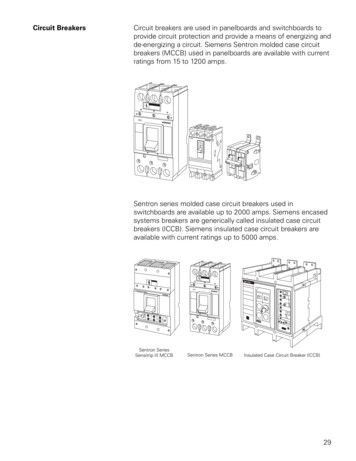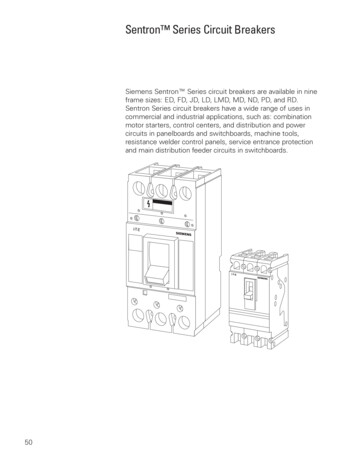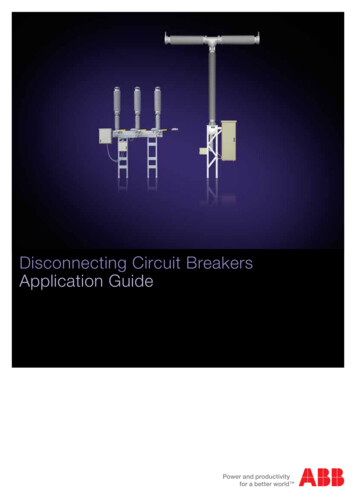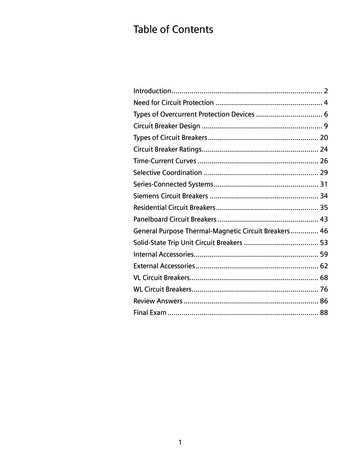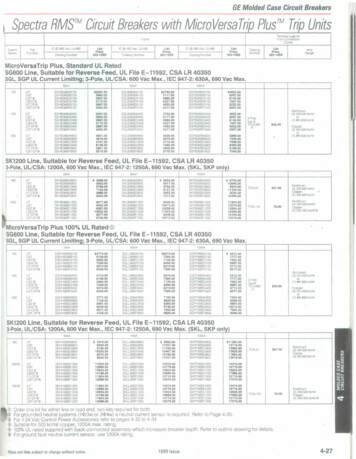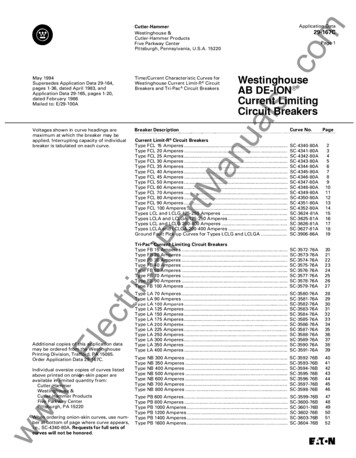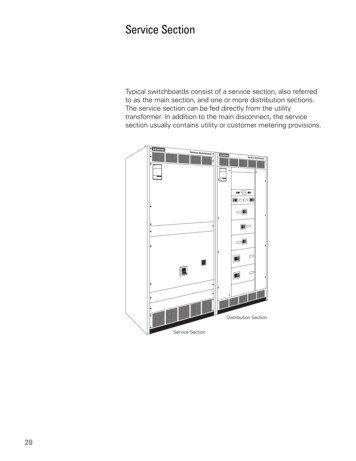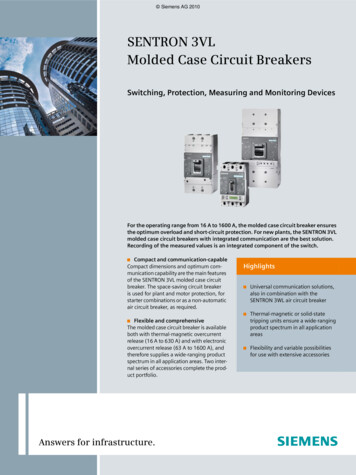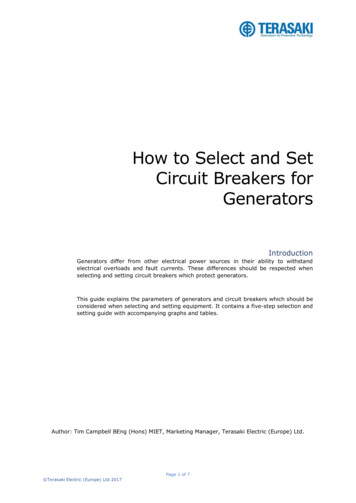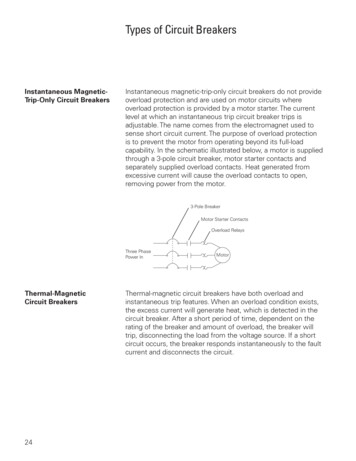
Transcription
Types of Circuit BreakersInstantaneous MagneticTrip-Only Circuit BreakersInstantaneous magnetic-trip-only circuit breakers do not provideoverload protection and are used on motor circuits whereoverload protection is provided by a motor starter. The currentlevel at which an instantaneous trip circuit breaker trips isadjustable. The name comes from the electromagnet used tosense short circuit current. The purpose of overload protectionis to prevent the motor from operating beyond its full-loadcapability. In the schematic illustrated below, a motor is suppliedthrough a 3-pole circuit breaker, motor starter contacts andseparately supplied overload contacts. Heat generated fromexcessive current will cause the overload contacts to open,removing power from the motor.3-Pole BreakerMotor Starter ContactsOverload RelaysThree PhasePower InThermal-MagneticCircuit Breakers24MotorThermal-magnetic circuit breakers have both overload andinstantaneous trip features. When an overload condition exists,the excess current will generate heat, which is detected in thecircuit breaker. After a short period of time, dependent on therating of the breaker and amount of overload, the breaker willtrip, disconnecting the load from the voltage source. If a shortcircuit occurs, the breaker responds instantaneously to the faultcurrent and disconnects the circuit.
Interchangeable TripCircuit BreakersThe user does not have access to the trip unit on some circuitbreakers. This means the trip unit cannot be changed withanother. Interchangeable trip is a design feature that is availableon some thermal-magnetic and solid state breakers. Theadvantage of a breaker with an interchangeable trip unit isthat the user can change the continuous current rating of thebreaker without replacing the breaker. This is done by replacingthe trip unit with one of a different rating.InterchangeableTrip UnitNote: Care must be exercised when consideringinterchangeable trip circuit breakers. A circuit breakermay be UL (Underwriters Laboratories, Inc. ) Listed fora specific interchangeable trip unit only. Circuit breakerframes are usually designed to prevent the installation ofan improper trip unit size or type.Molded Case SwitchSiemens molded case circuit breakers are available as a moldedcase switch. Molded case switches employ the same operatingmechanism as the thermal magnetic and magnetic only units.A preset instantaneous function is factory installed to allow theswitch to trip and protect itself at a high fault current, but theswitch provides no thermal overload protection.25
Current LimitingCircuit BreakersMany electrical distribution systems can deliver large shortcircuit currents to electrical equipment. This high current cancause extensive damage. Current limiting circuit breakers willreduce the current flowing in the faulted circuit to substantiallyless magnitude. This helps protect expensive equipment. Oneway to accomplish current limiting is with an additional set ofcontacts that feature two moveable arms. These are referred toas dual-pivot contacts, which separate even more quickly thanthe single-pivot contacts. The dual-pivot contacts are connectedin series with the single-pivot contacts. As with the single-pivotdesign, current flows in opposite directions through the contactarms, creating a magnetic repulsion. As current increases, themagnetic repulsion force increases.In an overload condition where current may only be one tosix times normal current, the contacts remain closed untilthe breaker trips. In a short circuit condition fault currentis extremely high, both sets of contact arms may opensimultaneously, generating high impedance arcs. The contactgap of the dual-pivot contacts increases more rapidly, thereforegenerating arc impedance more rapidly. Once the arcs areextinguished, the dual-pivot contacts close on their own due tospring tension. The single-pivot contacts are held open by thebreaker mechanism, which will have tripped during the fault andmust be manually reset.26
The frame on current limiting circuit breakers of this designis extended to allow room for the dual-pivot set of contacts.Siemens current limiting breakers are easily identified by a redlabel and can handle fault currents of up to 200,000 amps.Single-Pivot ContactsFrame ExtensionDual-Pivot Contacts27
Solid State Circuit BreakersSolid state circuit breakers function similarly to thermalmagnetic breakers. The basic breaker mechanism is stillmechanical. The tripping unit is solid state. Siemens Sentron Series solid state breakers are referred to as Sensitrip circuitbreakers. As with the thermal-magnetic tripping unit, theSensitrip circuit breaker tripping unit performs the followingthree functions: Senses magnitude of current flow Determines when current becomes excessive Determines when to send a trip signal to the breakermechanismSensitrip circuit breakers use a microprocessor to executenumerous functions programmed in the unit. These units havea greater degree of accuracy and repeatability. Adjustmentson the trip unit allow the user to select numerical valuesthe microprocessor will use in performing protective functions.Current sensors mounted in the trip unit monitor the valueof load current. The value of current is reduced to a lowlevel and converted to a digital voltage, which is used by themicroprocessor. The microprocessor continuously compares theline current with the value set by the user. When currentexceeds a preset value for the selected time, the trip unit sendsa signal to a magnetic latch. The magnetic latch opens thebreaker’s contacts, disconnecting the protected circuit from thepower source.PowerSourceSolid State BreakerSolid StateTripping SensorsProtectedCircuit28
Circuit Breaker RatingsAmpere RatingEvery circuit breaker has a specific ampere rating. The ampererating is the maximum continuous current a circuit breakercan carry without exceeding its rating. The main purpose ofcircuit breakers is to protect the conductor and equipment. Asmentioned earlier, conductors are rated by how much currentthey can carry on a continuous basis, known as ampacity. As ageneral rule, the circuit breaker ampere rating should match theconductor ampacity. For example, if the conductor is rated for 20amps, the circuit breaker should be rated for 20 amps. SiemensI-T-E breakers are rated on the basis of using 60 C or 75 Cconductors. This means that even if a conductor with a highertemperature rating were used, the ampacity of the conductormust be figured on its 60 C or 75 C rating.There are some specific circumstances when the ampere ratingis permitted to be greater than the current carrying capacity ofthe circuit. For example, motor and welder circuits can exceedconductor ampacity to allow for inrush currents and duty cycleswithin limits established by NEC .Generally the ampere rating of a circuit breaker is selected at125% of the continuous load current. This usually correspondsto the conductor ampacity which is also selected at 125% ofcontinuous load current. For example, a 125 amp circuit breakerwould be selected for a load of 100 amps.Voltage RatingCircuit breakers are also rated according to the maximumvoltage they can handle. The voltage rating of the circuit breakermust be at least equal to the circuit voltage. The voltage ratingof a circuit breaker can be higher than the circuit voltage, butnever lower. For example, a 480 VAC circuit breaker could beused on a 240 VAC circuit. A 240 VAC circuit breaker could notbe used on a 480 VAC circuit. The voltage rating is a functionof the circuit breakers ability to suppress the internal arc thatoccurs when the circuit breaker’s contacts open.NEC and National Electrical Code are registered trademarks of theNational Fire Protection Association.29
Circuit Interrupting Ratings30Circuit breakers are also rated according to the level of faultcurrent they can interrupt. When applying a circuit breaker,one must be selected which can sustain the largest potentialshort circuit current which can occur in the selected application.Siemens circuit breakers have interrupting ratings from 10,000to 200,000 amps. To find the interrupting rating of a specificcircuit breaker refer to the Speedfax catalog.
Time-Current CurvesTime in SecondsTime-current curves, similar to the one shown on the followingpage, are used to show how fast a breaker will trip at anymagnitude of current. The following illustration shows howa time-current curve works. The figures along the bottom(horizontal axis) represent current in amperes. The figures alongthe left side (vertical axis) represent time in seconds.Current in AmperesTo determine how long a breaker will take to trip at a givencurrent, find the level of current on the bottom of the graph.Draw a vertical line to the point where it intersects the curve.Then draw a horizontal line to the left side of the graph and findthe time to trip. For example, in this illustration a circuit breakerwill trip when current remains at 6 amps for .6 seconds. Notethat the higher the current, the shorter the time the circuitbreaker will remain closed. Time-current curves are usuallydrawn on log-log paper, and the horizontal line is in multiples ofthe breaker’s continuous current rating.From the information box in the upper right hand corner,note that the time-current curve illustrated on the followingpage defines the operation of a CFD6 circuit breaker. For thisexample, operation with a 200 ampere trip unit is shown.31
32
Overload ProtectionComponentThe top part of the time-current curve shows the performanceof the overload trip component of the circuit breaker. Timecurrent curves are shown as bands, and the actual performanceof any one breaker can fall anywhere within the band. Usingthe example CFD6 breaker and 200 ampere trip unit, thetime the breaker will trip for any given overload can easily bedetermined using the same procedure as previously discussed.For example, the breaker will trip between 25 seconds and 175seconds at 600 amps with a 40 C ambient temperature, whichis 3 times the trip unit rating. This is illustrated by the timecurrent curve on the following page.Instantaneous TripComponentThe bottom part of the time-current curve shows theperformance of the instantaneous trip component (short circuit)of the circuit breaker. The maximum clearing time (time ittakes for breakers to completely open) decreases as currentincreases. This is because of the blow-apart contact designwhich utilizes the magnetic field built-up around the contacts.As current increases the magnetic field strength increases,which aids in opening the contacts. This circuit breaker has anadjustable instantaneous trip point from 900 A to 2000 A, whichis 4.5 to 10 times the 200 A trip unit rating. If the trip pointadjustment is set to minimum (900 A), and a fault current of 900amps or greater occurs, the breaker will trip within 1 cycle (16.8ms). If the trip point setting is set to maximum (2000 A), and afault current of 900 amps occurs, the breaker will trip betweenapproximately 12 and 55 seconds. A greater fault current willcause the breaker to trip faster.33
34
Selective CoordinationSelective coordination is the application of circuit protectivedevices in series such that under overload or fault conditions,only the upstream device nearest the fault will open. The restof the devices remain closed, leaving other circuits unaffected.In the following example a short circuit has occurred in thecircuit fed by branch circuit breaker “C”. Power is interrupted toequipment supplied by circuit breaker “C” only. All other circuitsremain unaffected.ABC35
Circuit BreakerCoordinationTime current curves are useful for coordinating circuit breakers.If the trip curves of main breaker “A”, feeder breaker “B”, andbranch breaker “C” are placed on the same graph, there shouldbe no overlapping, indicating the breakers are coordinated.The three circuit breakers in the following example have beencoordinated so that for any given fault value, the tripping timeof each breaker is greater than the downstream breakers. In thefollowing illustration circuit breaker “C” is set to trip if a 400amp fault current remains for .04 seconds. Circuit breaker “B”will trip if the fault remains for .15 seconds, and circuit breaker“A” if the fault remains for .8 seconds. If a 400 amp fault occursdownstream from circuit breaker “C”, it will trip first and clearthe fault. Circuit breakers “A” and “B” will not trip.ATime in Seconds0.8Breaker “A”B0.15Breaker “B”C0.04Breaker “C”400Current in Amperes36
Series-Connected SystemsWhen selecting circuit breakers it is extremely important toknow both the maximum continuous amperes and availablefault current. This is true for any circuit breaker that isselected for any application. NEC article 110.9 states:Equipment intended to interrupt current at fault levels shall havean interrupting rating sufficient for the nominal circuit voltageand the current which is available at the line terminals of theequipment.Equipment intended to interrupt current at other than faultlevels shall have an interrupting rating at nominal circuit voltagesufficient for the current that must be interrupted.There are two ways to meet this requirement. The first methodis to select circuit breakers with individual ratings equal to orgreater than the available fault current. This means that, in thecase of a building with 65,000 amperes of fault current availableat the service entrance, every circuit breaker must be rated at65,000 amperes interruptingcapacity (AIC).A - Main Breaker (65,000 amps)B - Feeder Breaker (65,000 amps)C - Branch Breaker (65,000 amps)NEC and National Electrical Code are registered trademarks of theNational Fire Protection Association. Reprinted with permission from NFPA70-2005, the National Electrical Code , Copyright 2004, National FireProtection Association, Quincy, MA 02269.37
The second method is to select circuit breakers with a seriescombination rating equal to or greater than the available faultcurrent at the service entrance. The series-rated concept is thatthe main upstream breaker must have an interrupting ratingequal to or greater than the available fault current of the system,but subsequent downstream breakers connected in series canbe rated at lower values. For example, a building with 65,000amperes of available fault current might only need the breakerat the service entrance to be rated at 65,000 AIC. Additionaldownstream breakers can be rated at lower values. The seriescombination must be tested and listed by UL.A - Main Breaker (65,000 amps)B - Feeder Breaker (22,000 amps)C - Branch Breaker (10,000 amps)Siemens series-rated breakers are listed under “IntegratedEquipment Short Circuit Ratings” in the Siemens Speedfax catalog, and in the UL “Recognized Components Directory”(yellow books) Volume 1. Your Siemens sales engineer canprovide more information on Siemens series-rated circuitbreakers.38
Review 31.magnetic-trip-only circuit breakersprotect against short circuits, but provide no overloadprotection.2.magnetic circuit breakers have bothoverload and instantaneous trip features.3.Siemens current limiting circuit breakers can interruptup to amps.4.The maximum continuous current a circuit breaker cancarry is known as its rating.5.The upper part of a time-current curve representsthe component, whilethe lower part of a time-current curve represents theinstantaneous trip component.6.Circuit breaker will allow the circuitbreaker supplying a circuit that faults to trip, but allupstream circuit breakers will remain unaffected.39
Catalog NumbersTo help identify each type of circuit breaker, a catalog numberis assigned. The catalog number provides a description of thecircuit breaker. There are five parts to the standard I-T-E molded case circuit breaker catalog number. The following figureillustrates a typical catalog number.Part 1Part 1 signifies the circuit breaker’s frame type. There arefour basic frame types available: normal duty, heavy duty,extra heavy duty, and fuseless current limiting. Most normalduty breakers are rated up to 240 VAC and have a maximuminterrupting capacity of 10,000 or 22,000 amps. Heavy dutybreakers have a stronger case. They are rated up to 600 VACand have interrupting capacities up to 65,000 amps. This is theSentron Series. There are eight basic Sentron Series frames:ED, FD, JD, LD, MD, ND, PD and RD. Extra heavy duty framesare rated up to 600 VAC and have interrupting capacities up to100,000 amps.An extra heavy duty circuit breaker will have an “H” in the frametype designation. For example, one type of normal duty circuitbreaker is identified as QP. The same circuit breaker in an extraheavy duty frame is identified as HQP.This is also true for the Sentron Series. For example, one typeof heavy duty Sentron circuit breaker might be identified asFD6. The same Sentron circuit breaker in an extra heavy dutyframe is identified as HFD6.A similar method is used to identify current limiting frames.For example, a CED6 circuit breaker is a current limiting circuitbreaker and an ED6 frame breaker is not.40
Part 2Part 2 indicates the number of poles on the circuit breaker.Sentron Series circuit breakers can be provided with 1, 2, or 3poles. The number of poles reflects the number of ungroundedphases that are connected. For example, a 1-pole breaker mightbe used on a simple lighting circuit, and a 3-pole breaker mightbe used on a 3-phase AC motor.1-PoleBreakerLightSwitchSingle PhasePower InLight3-PoleBreakerThree PhasePower InPart 3Motor Starter ContactsMotorPart 3 identifies the style of breaker.BMFTWS 40 C calibrated complete breaker50 C calibrated complete breakerBreaker frame onlyTrip unit calibrated for 40 CTrip unit calibrated for 50 CMolded case switchPart 4Part 4 shows the circuit breaker’s continuous current rating. Inthe example shown on the previous page it is 125 amps.Part 5Part 5 is used to identify a special circuit breaker types, such asautomatic switches.41
Residential and CommercialCircuit BreakersSiemens has several circuit breakers that are used in residential,commercial and light industrial applications. These circuitbreakers are normally plug-in or bolt-on types that mount inload centers or panelboards. Other types are also available,for example, circuit breakers that mount on a DIN rail. Thereare several variations of circuit breakers, and this section willattempt to explain the most popular of them. The specificratings for each circuit breaker can be found in the Speedfax catalog.42
EQ Frame Circuit BreakersEQ frame circuit breakers, which includes QP, BL, and BQ typecircuit breakers, are UL Listed for use with EQ load centers.QP Circuit BreakersOne type of circuit breaker that belongs to the EQ family is theQP plug-in breaker. Depending on the specific QP type circuitbreaker, the following ratings are available:Interrupting ratingContinuous ampere ratingVoltsNumber of poles10,000, 22,000, or 65,000 amps15-125 amps120/240 VAC or 240 VAC1, 2, or 3For example, referring to the circuit breaker section of theSpeedfax catalog, note that a 1-pole, 15 amp QP breaker, ratedfor an interrupting capacity of 10,000 amps at 120/240 VAC is aQ115. A 20 amp breaker is a Q120.The following illustration shows a QP 1-pole breaker installedand an interior from an EQ load center.43
QP breakers can be used in single family homes where theavailable fault current does not normally exceed 10,000 amps.In some instances where fault current exceeds 10,000 amps,a QPH might be selected. In apartments, condominiums, andcommercial buildings the available fault current is normallygreater than 10,000 amps. Series-rated circuit breakers canbe used. For example, a QPH feeder disconnect, with aninterrupting capacity of 22,000 amps might be placed in front ofa QP branch with an interrupting capacity of 10,000 amps. Thereare restrictions when using series-rated breakers. Refer to theSpeedfax catalog for acceptable series-rated combinations.22,000 Amps Available Fault CurrentQPH (22,000 Amps Interrupting Rating)QP (10,000 Amps Interrupting Rating)BL and BQ BreakersBL and BQ bolt-on breakers also belong to the EQ family.These breakers bolt directly to the power bus on panelboards incommercial and industrial applications, or the tab on the BQ canalso be used to accept wire connectors.BL 2-Pole44
Depending on the specific BL type circuit breaker, the followingratings are available:Interrupting ratingContinuous ampere ratingVoltsNumber of poles10,000, 22,000, or 65,000 amps15-125 amps120/240 VAC or 240 VAC1, 2, or 3For example, referring to the circuit breaker section of theSpeedfax catalog, it can be seen that a 1-pole, 15 amp BLHbreaker, rated for an interrupting capacity of 22,000 amps at120/240 VAC is a B115H. A 20 amp breaker is a B120H.Another bolt-on circuit breaker belonging to the EQ family is theBQ breaker. A BQ 2-pole breaker is illustrated below.BQ 2-Pole45
Depending on the specific BQ type circuit breaker, the followingratings are available:Interrupting ratingContinuous ampere ratingVoltsNumber of poles10,000, 22,000, or 65,000 amps15-125 amps120/240 VAC or 240 VAC1, 2, or 3For example, referring to the circuit breaker section of theSpeedfax catalog, note that a 2-pole, 20 amp BQ breaker, ratedfor an interrupting capacity of 10,000 amps at 120/240 VAC is aBQ2B020.BQD Type Circuit BreakersBQD type circuit breakers (not shown) are panel-mount-onlybreakers for light industrial loads or 277 VAC lighting. Dependingon the specific BQD type circuit breaker, the following ratingsare available:Interrupting ratingContinuous ampere ratingVoltsNumber of poles4614,000 or 65,000 amps15-100 amps277 or 277/480 VAC1, 2, or 3
CQD Circuit BreakerThe CQD type circuit breaker is similar to the BQD, butmounts on a DIN rail. The one and two pole devices have ahigh intensity discharge (HID) rating for high pressure lighting.Depending on the specific CQD type circuit breaker, thefollowing ratings are available:Interrupting ratingContinuous ampere ratingVoltsNumber of poles14,000 or 65,000 amps15-100 amps120, 240, 277 or 277/480 VAC1, 2, or 3DIN RailCQD 3-Pole47
QJ Circuit BreakersQJ type circuit breakers can be used as main circuit breakersin EQ 3-phase load centers. They are also used as branchcircuit breakers in commercial panelboards and switchboards.Depending on the specific QJ type circuit breaker, the followingratings are available:Interrupting ratingContinuous ampere ratingVoltsNumber of polesQJ 2-Pole4810,000, 22,000, or 42,000 amps60-225 amps240 VAC2 or 3
QD Circuit BreakersQD type circuit breakers are UL Classified for certain SquareD Company load centers in place of Square D QO circuitbreakers. A panelboard compatibility list is packaged with eachSiemens QD circuit breaker. Siemens QD circuit breakers areto be used only in those Square D panelboards shown on thecompatibility list. Depending on the specific QD type circuitbreaker, the following ratings are available:Interrupting ratingContinuous ampere ratingVoltsNumber of poles10,000 amps15-60 amps120/240 VAC1 or 2QD 1-PoleReview 41.Part one (1) of the catalog number identifies the circuitbreaker’s type.2.An extra heavy duty FD6 type circuit breaker will beidentified as .3.The continuous ampere range of the QP type circuitbreakers is from to amps.4.The Siemens type circuit breaker canbe used as a replacement for a Square D QO circuitbreaker in certain Square D load centers.5.The type circuit breaker mounts on a DINrail.49
For example, a 125 amp circuit breaker would be selected for a load of 100 amps. Voltage Rating Circuit breakers are also rated according to the maximum voltage they can handle. The voltage rating of the circuit breaker must be at least equal to the circuit voltage. The voltage rating of a circuit breaker can be higher than the circuit voltage, but
